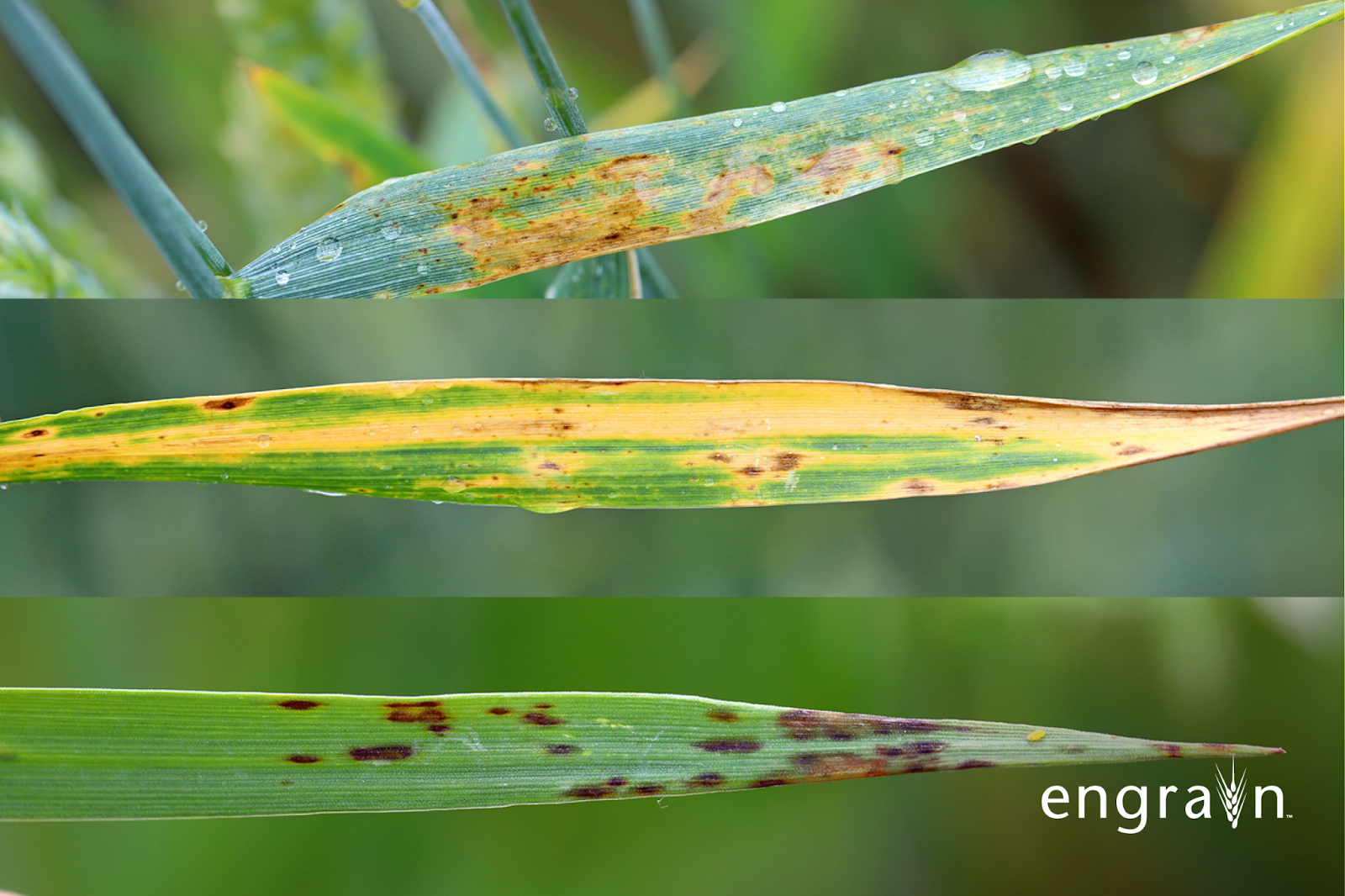Disease management is crucial to ensure optimal wheat’s yield and quality. Wheat diseases and environmental factors can negatively impact wheat yield and quality. This affects grain supply and drives up the price for consumers.
Seemingly overnight, your precious wheat crop, or “triticum aestivum,” could be ruined by the presence of a nasty disease. These kinds of crop infestations harm your grain by making it inedible — costing money and wasting valuable resources.
What’s more, environmental factors can place added strain on your wheat crops by reducing crop yield and lowering grain quality altogether.
When taken together, wheat diseases and unfortunate environmental factors can seriously harm the wheat supply.
This article will explain the most common diseases affecting your wheat crops, how environmental factors might contribute, and how they both affect the wheat supply.

How do environmental factors affect the wheat supply?
Environmental factors can harm the wheat supply by damaging wheat, meaning there’s less to go around.
Reduced crop yields and lower grain quality are two of the most common environmental problems that lessen the wheat supply.
Environmental factors like drought, heat stress, and floods can reduce crop yield.
They also directly damage the wheat by causing poor plant growth, damaging the plant’s tissue, and causing nutrient deficiencies. This leads to poor plant health.
This directly impacts the amount of wheat available in the international market, as there simply isn’t as much in circulation. Plus, these factors lower the wheat grain’s quality. For instance, higher temperatures can lead to reduced protein content in wheat grain.
Environmental problems can lead to a reduced wheat supply and lessen the quality of available grain.
Climate change can also make these environmental problems worse, increasing the likelihood of droughts and floods.
Floods and excessive rain cause problems for the wheat supply because excessive moisture can lead to fungal infections like root rot. This affects the grain’s nutritional value and lowers the crop’s desirability.
Environmental factors can aggravate already existing issues with diseases and lead to a potentially troublesome cocktail for farmers and millers.
The most common wheat diseases
Numerous ailments can afflict wheat, and any of these diseases have the potential to devastate your wheat harvest. Even farmers and producers who prioritize their crops’ health can still be taken by surprise. The impact of a wheat disease largely hinges on the specific disease affecting the wheat plant.
Nevertheless, some diseases are more common than others. For example, leaf rust is a common type of fungal disease. It produces infected spores that infest the wheat plant’s tissue while it’s still alive.
In contrast, blight is a bacterial disease associated with high humidity. Some strains can reduce crop yield by 30% to 50%, while some kinds of wheat, such as winter wheat, are especially susceptible to rust and blight.
Below are some of the most common diseases that can infect your wheat crops.

Rust
Wheat rust disease is a fungal disease that can devastate wheat plants. Rust fungi are concerning because they’re so common and can infect and decimate your wheat crops.
The wheat rust pathogen is caused by the fungi Puccinia graminis, Puccinia triticina, and Puccinia striiformis f. Spores transmit the disease and wind and rain transport it to other plants, like a wheat leaf. The spores can stay active for long periods, making them hard to stop once active.
Leaf rust can be found on the sheath of the plant but is found mainly on its leaf blade. Scabs and pustules are usually scattered or clustered on the leaf.
Some factors may encourage wheat rust, including humid weather conditions and wet leaves.
Three types of rust found in wheat are:
- Stem rust
- Leaf rust
- Stripe rust (also known as yellow rust)
According to some research, stripe rust or yellow rust can cause up to 60% reduction in wheat yields.
Cool, moist weather is favorable to the development and spread of yellow rust and leaf rust, as it provides the perfect condition for rust spore growth and reproduction. Stem rust requires warmer weather to be successful.
Here are some of the ideal temperatures for rust to grow:
- Stem rust develops at temperatures between 65° and 85°F, though the disease can grow at lower or higher temperatures (between 59° and 104°F).
- Leaf rust develops at temperatures of around 59° to 71°F.
- Stripe rust is a lower-temperature disease generally found at higher altitudes and cooler climates. The ideal temperature for the disease to develop is around 50° to 59°F.
Conversely, hot and dry conditions limit the growth and spread of stripe rust. Dryer conditions can lead rust spores to dry up and become less potent. Lower humidity can also limit spores from spreading from a host plant to healthy plants.
Ultimately, these temperatures help boost the infection rate and severity of rust infections, leading to more harm to the wheat supply.
Be careful not to mistake leaf rust for Pyrenophora tritici-repentis. This disease is similar in appearance, containing dark eyespots surrounded by yellow (often called tan spots). However, it’s not from the same fungus that produces the rust disease.
Nevertheless, Pyrenophora tritici-repentis is still another deadly form of wheat disease and is most commonly found in durum wheat.
Smut
There are two types of smut: loose smut and stinking smut. Loose smut is caused by the fungus Ustilago tritici, whereas stinking smut results from the fungi T. laevis and Tilletia tritici.
In its most severe cases, loose smut can reduce wheat yields by 25% (though it’s usually minimal in most cases, at 1% or below). Its impact on the small grain is negligible, and the infected grain isn’t altered in appearance.
However, stinking smut or “common bunt” reduces grain quality and crop yield, sometimes devastatingly, with potential yield losses of around 75% to 80%.
Weather influence on smut hasn’t been studied as much as on leaf rust. However, weather’s specific impact on smut diseases will vary depending on which smut pathogen has been used to infect a plant.
Still, we know strong winds can increase the ability of the smut to infect more wheat plants because the smut’s spores disperse via air.
Mildew
Mildew is a powdery fungal leaf disease that can reduce yield and grain quality. It thrives in states like Florida, preferring temperatures around 68 to 71 degrees Fahrenheit and high humidity.
Powdery mildew can harm wheat, as it diverts nutrients from the wheat to the fungus. It can incur yield losses of around 20%, although usually less. It’s a common problem for spring wheat.
Mildew spores spread by wind and rain, which helps mildew spread faster under the right environmental conditions. Plus, heavy rainfall and long periods of moisture help precipitate mildew growth (which is why it’s a common problem for producers in Australia).
Yet, hot and dry weather can slow down or even eradicate the disease’s spread. Of course, some wheat varieties like Scepter, Vixen, Wyalkatchem, Zen, and Corack wheat are more susceptible to mildew than others, so the right crop management, like crop rotation and fertilization, can aid in minimizing the severity and spread of mildew infections.
Blight
Fusarium head blight (FHB) is a nasty fungal disease caused by the fungus Fusarium graminearum. It affects kernel development, reducing the yield and quality of your wheat crop. It can also infect grains with a fungal toxin called mycotoxin.
The impact of mycotoxin can be considerable, especially on milling and baking operations. That’s because the fungal toxin directly impacts the baking and milling quality of wheat and livestock feed.
Losses can exceed 45% if the disease is particularly severe.
FHB is commonly confused with black chaff due to both infections discoloring wheat. Black chaff is a bacterial disease that also infects wheat. It’s commonly confused with FHB because its symptoms are similar (e.g., dark purple streaks on the glume and awns and yellow lesions on the wheat plants’ spikelets).
The most common way to spot FHB is by looking for premature discoloration or bleaching in wheat heads or wheat plant’s floret.
Blight pathogens spread best in cooler but humid weather conditions, around 70 to 77 degrees Fahrenheit. Yet, they prefer high humidity and moist soil, as it provides an ideal ecosystem for their pathogens to multiply. In fact, a higher humidity level increases the variability of the pathogens and the disease severity.
Rain also boosts contagion levels by helping fungal spores move from plant to plant easier.
Drought conditions can also negatively affect wheat plants by weakening the wheat plant’s immune system. This makes them more vulnerable to nasty infections.
Blotch
Leaf blotch occurs when the fungi Stagonospora nodorum and Septoria tritici blotch leaves. The fungi release pathogens that reduce the green leaf and lower leaf areas once they’ve contaminated the plant, meaning they don’t get the nutrients they should gain from photosynthesis. This typically causes the plant to die.
Blotch causes significant annual yield loss worldwide (up to 50% in badly affected crops). In the United Kingdom, it’s the most damaging fungal disease affecting winter wheat.
Luckily, blotch is easy to spot. You can identify it by spots on leaves and reddish brown and pale gray blotches. A bad case of the disease can mean the entire leaf is covered in lesions.
Blotch disease favors cool and humid weather conditions to thrive because the fungal pathogens responsible for the disease are best suited to temperatures of 60 to 77 degrees Fahrenheit. These weather conditions help prompt the germination and spread of the blotch fungal spores.
Although it’s best to note that conditions that are too warm and dry can also slow the development of blotch disease. That’s because they create unfavorable conditions for the fungal spores to germinate.
Nevertheless, long periods of dry conditions can weaken the plant and make it susceptible to infection due to a lack of water.
Fungal vs. bacterial wheat diseases
There might not seem to be a huge difference between fungal diseases and bacterial wheat diseases. That said, some differences can reduce your grain yield.
Typically, fungal plant diseases have these characteristics:
- They favor wet and humid weather.
- Some fungal diseases produce mycotoxins, like Fusarium head blight, or nasty substances like deoxynivalenol. These can harm humans and livestock if consumed in infected grain or flour.
There is a dissimilarity when considering bacterial wheat diseases: Bacterial wheat diseases usually persist in contaminated soil and infected plant remains. Wet soil in humid conditions can worsen these diseases, as the soil serves as an excellent petri dish for multiplication.
The key takeaway from both types of wheat disease is that they can harm crops, and both are affected by the weather (which acts as a catalyst for diseases to strengthen and grow). They both pose a significant danger to wheat crops — whether winter wheat or spring wheat.
How wheat diseases affect wheat supply
Wheat diseases can dramatically impact the overall wheat supply in three ways: by damaging the wheat’s quality in circulation, killing the plants outright, or reducing the wheat’s desirability for consumption by affecting its taste.
In the case of blight, mycotoxins can harm humans and livestock. A plant infected with stinking smut results in lost time growing a plant that livestock won’t eat due to its smell.
All of these impact the supply chain through economic means, as well. That’s because wasted crops lose money for businesses, and the wasted crops cause supply chain issues. This increases the cost for millers to procure the wheat.
Individual wheat diseases can incur huge losses. For example, it’s estimated that leaf rust causes an average annual yield loss of around 3 million tons in China.
Between 2000 and 2004, it was responsible for $350 million in losses in the United States. In 2020, overall wheat diseases reduced wheat bushels by 7.7% across the U.S. and Canada.
Ultimately, diseases negatively impact the wheat available in the supply chain by reducing it, causing prices to increase.
If wheat is unavailable in the USA, millers must import from places like Argentina and Eastern Europe. The added transportation costs make this expensive.
What impact do weather patterns have on wheat disease outbreaks?
Weather patterns significantly impact wheat disease outbreaks and their severity. Temperature, humidity, and precipitation are the ones to watch for because they affect the growth and spread of pathogens that cause diseases in wheat crops.
Here are some main ways weather patterns impact wheat disease:
- Wind. Strong winds have the possibility of spreading fungal spores across wheat fields. The wind can carry pathogens like powdery mildew and rust.
- Humidity. High humidity and wet soil are ideal for growing wheat pathogens. It offers a perfect breeding ground for them to grow in number and strength. Meanwhile, excess moisture can cause diseases like stem rust and leaf rust.
- Precipitation. Heavy rainfall helps spread diseases by transporting fungal spores from diseased host plants to healthy ones. It can also ensure high humidity and wet soil. That’s why producers regularly tillage, called “tillering.” Tillage means planting seedlings into a well-drained, mellow seedbed to reduce infection by soil-borne pathogens.
- Temperature. High temperatures nurture pathogens in their growth stage and keep pathogens growing, increasing disease severity. For example, fusarium head blight excels in hot and humid weather.
These are the most common ways environmental factors encourage wheat pathogens to grow.
Environmental factors and wheat diseases help each other spread and infect healthy plants nearby.
However, disease management can prevent disease susceptibility. For example, using fungicides can boost disease resistance, or using resistant cultivars, non-susceptible wheat cultivars, and seed treatments can also stop the incidence of epidemics from reoccurring.
Understanding the causal effect between weather patterns and wheat disease outbreaks is crucial for forecasting potential damages to the wheat supply. It helps ensure a plentiful supply of high-quality wheat products.
Discover how VolMAX Flour Technologies can benefit your milling operations
You don’t need a Ph.D. in plant pathology or phytopathology or an agronomic expert background to understand the danger wheat diseases and environmental factors pose to crops.
Disease management can be difficult, but learning what impacts the wheat supply can give you a head start so you can prepare.
Baking and milling operations don’t need to be hard. VolMAX Flour Technologies helps address low protein in wheat and manage the high costs of raw materials.
It works by using an enzyme technology that allows millers like you to blend soft, low-protein wheat with high-protein wheat to improve loaf volume, water absorption, and crumb texture.
Overall, VolMAX helps you produce similar characteristics to premium wheat products.
Experience the latest in food technology.
